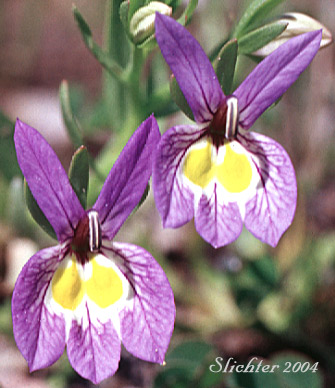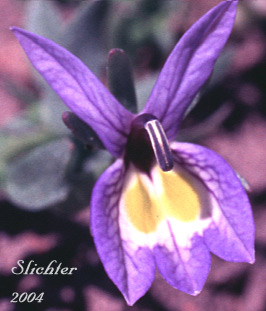Cupped Downingia, Harlequin Calicoflower
Downingia insignis

Cupped downingia as seen along the South Loop Road of the Steens
Mt in southeastern Oregon..........June 20, 2004. Note the bent and
exserted stamen tube and the purple markings at the base of the lower lip, both
key identifying characteristics for this species.
 The
photo at right shows a clowe-up view of the flower of cupped downingia as seen
along a small vernal creek along the South Loop Road at the Steens Mt in southeastern
Oregon..........June 20, 2004.
The
photo at right shows a clowe-up view of the flower of cupped downingia as seen
along a small vernal creek along the South Loop Road at the Steens Mt in southeastern
Oregon..........June 20, 2004.
Characteristics:
Cupped downingia is an attractive annual wildflower of vernally
moist areas with simple to branched stems spreading or ascending at the base
and erect at the upper ends. The often hollow stems arise from 5-20 cm. The
oblanceolate leaves and bracts range from 0.8-1.5 cm long.
The flowers are sessile in leafy bracted spikes and are subtended
by elongated hypanthiums (which may cause the flowers to look long pedicelled).
The 5 calyx segments are lanceolate-elliptic in shape with blunt tips and each
measures 3-7 mm long. The corolla is strongly two-lipped with two upright upper
lobes and three larger lower lobes. The corolla measures 8-15 mm long and is
blue to bluish-purple with darker veins. The lower lip also contains two white-margined
yellow to greenish spots and purplish markings or spots at the mouth of the
throat. The corolla tube is 3-4 mm long and is broadly funnelform. The lower
lip is 6-9 mm long with broad, ovate lobes. The upper lip is 6-9.6 mm long with
erect lanceolate lobes which are parallel or crossed. The stamen-tube extends
beyond the mouth of the flower with the anther tube bent at a right angle from
its junction with the filament tube (See flower photos on this page.).
Habitat:
Cascade downingia is found on wet ground in marshes, wet meadows,
and the edges of vernal ponds below 1650 meters of elevation.
Range:
Cupped downingia may be found from southern Malheury County
in southeastern Oregon south to northwestern Nevada (north of Reno) and west
to northeastern California.

The photo above shows a close-up side view
of the flower of cupped Downingia as seen along a small vernal creek along the
South Loop Road at the Steens Mt in southeastern Oregon.........June 20,
2004. Note the stamen tube which extends beyond the throat of the flower,
and the stamen tube at its tip which is reflexed downward at a right angle to
the rest of the tube.

The photo above shows the stem leaves and a
side view of the flower of cupped Downingia as seen along a small vernal creek
along the South Loop Road at the Steens Mt in southeastern Oregon.........June
24, 1999.
Paul Slichter



